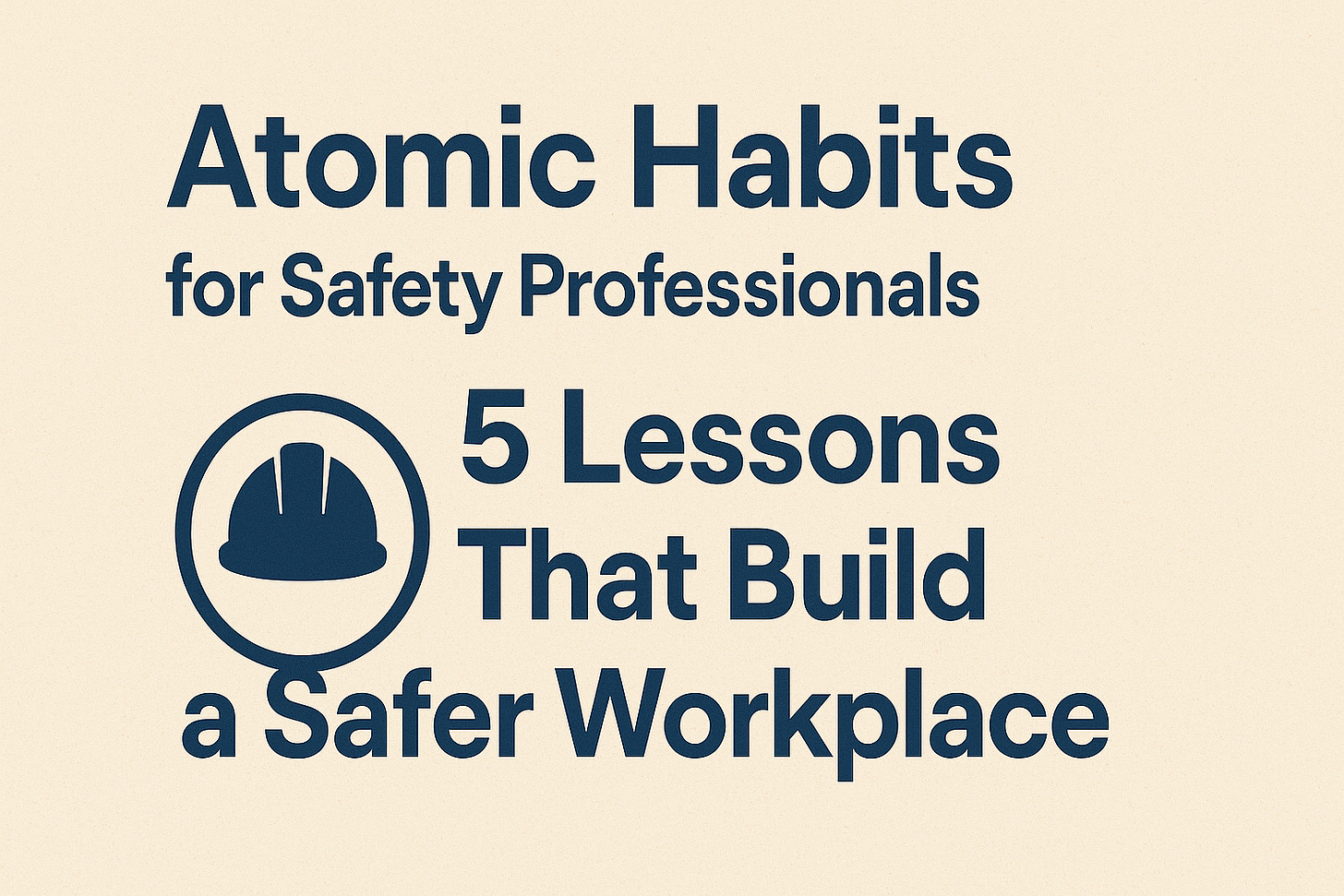Atomic Habits for Safety Professionals: 5 Lessons That Build a Safer Workplace
Hello and welcome to this week’s edition of Safety Pro Weekly.
Atomic Habits, written by James Clear in 2018 has sold over 25 million copies, became a New York Times bestseller and has now been translated into over 60 languages.
Widely praised for it’s accessible and practical approach to building better habits, the book draws on the fields of biology, psychology and neuroscience. In it, Clear explains how small life changes can compound into significant transformations over time.
The book has lots to teach us as safety professionals.
Here are my 5 biggest takeaways from Atomic Habits we can apply to workplace safety:
1. Focus on Systems, Not Goals
In the book, Clear says, “You do not rise to the level of your goals. You fall to the level of your systems.”
This concept of process over outcome is often seen in the philosophy of successful people in all walks of life. As safety professionals, we have much more control over the process and systems we put in place than the actual outcome of specific events.
The lesson here is instead of setting targets like “zero injuries,” that are largely influenced by outside factors, build systems that make safety routine.
For example:
Embed pre-shift safety checks into daily workflow.
Use regular toolbox talks to keep safety top of mind.
Use checklists and visuals to reinforce safe behavior.
Review processes regularly, not just after incidents.
2. Make Good Habits Obvious
Clear teaches us that habits start with cues. A cue is a trigger or reminder that nudges us toward a particular habit. People respond best to visual and environmental triggers.
What you want to do is create a consistent, visible cue tied to a natural part of the workflow and use this to reinforce the response you want to build.
For example, placing a tag on a machine’s power switch that says, “Inspect before start.” This is a perfect visual cue that triggers the habit of the pre-shift inspection.
Some other examples are:
Place PPE reminders where work starts, not in the lunchroom.
Use dashboards or whiteboards showing current safety metrics to keep awareness high.
Forklift safety posters placed in view of where the machines are parked between shifts as a reminder before starting.
3. Make Safe Actions Easy
I love this one.
Clear’s instruction here is to reduce friction for good habits and increase friction for bad ones.
You want to make it as easy as possible to follow the habits you want to reinforce and as difficult as possible to follow habits you’d like to eliminate. Most of tend to go with the path of least resistance. When the safe option becomes the easiest one, you’re going to get buy-in.
Try this:
Store gloves and goggles at point of use so they are easy to reach, not in a cabinet across the floor.
Reduce the complexity of hazard or incident reporting forms. If it’s going to take all day to complete the forms, people will resist filling them out or provide a bare minimum of information.
Find ways to make unsafe behaviour more difficult than the safer option. For example, use auto shutoff systems so that leaving a guard off a machine creates more hassle than leaving it on.
4. Reinforce with Immediate Rewards
Rewards have a way of making good habits stick.
When you attach rewards to the habits you’re trying to build, you automatically reinforce them. We all like receiving rewards.
The reward itself need not be elaborate or necessarily even material. Just a bit of recognition goes a long way.
The key is that the reward needs to closely follow the action you want to reinforce. Immediate positive reinforcement builds momentum faster than quarterly awards. The longer you wait, the less the reward will be tied to the action and the less effective it will be.
Give quick, genuine recognition for safe actions, “Thanks for catching that hazard”.
Highlight small wins at shift huddles.
Track positive observations logged if you have a BBS system.
5. Identity Over Outcomes
For me, this is one of the most powerful lessons in the book.
Clear teaches us that the most effective way to change your habits is to change your identity.
Most people look at identity as the product of actions and outcomes. Clear turns this notion on its head. By establishing an identity as a person who upholds a certain standard, you subconsciously begin to live up to that standard. When your actions align with who you believe you are, they reinforce this self-image, rather than fight against it. The more you can establish an identity as a safe organization, the more you encourage safe habits.
Here are some ideas for this:
Don’t just tell teams to follow safety rules, help them see themselves as safety-minded professionals.
Encourage peer accountability. Reinforce the notion of looking after each other.
Model the identity daily. Approach the job as a safety coach, not a safety cop.
The key message I want to end with is that small, consistent habits compound into culture. The more you can establish a culture as a workplace where safe practices are the norm, the more people will begin to live up to the message.
A safe workplace isn’t built by a few people in the safety department writing procedures, it’s built in the daily habits of everyone on site. It’s built by workers wearing PPE, forklift operators driving safely, supervisors coaching safe behaviours. In a thousand little ways, your safety culture is being built by small actions and habits of employees, managers and senior leadership.
That’s it for this week’s edition of Safety Pro Weekly. Let me know in the comments what you’re doing to help promote small safety habits in your workplace. Would love to compare notes and share ideas.
Safety Pro Weekly is published every Tuesday on LinkedIn and Substack.
Cheers,
Dan.



